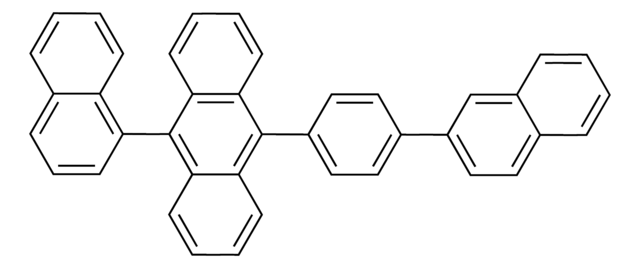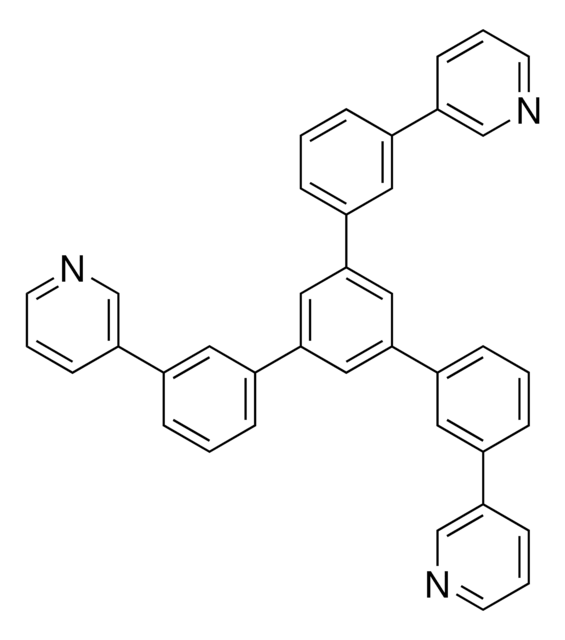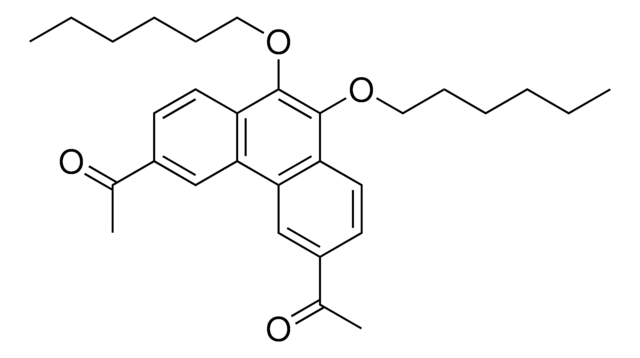925748
N,N′-Bis(2-methylphenyl)-N,N′-bis(6-tert-butyldibenzofuran-4-yl)pyrene-3,8-diamine
≥97%
Synonym(s):
BD
Sign Into View Organizational & Contract Pricing
All Photos(1)
About This Item
Empirical Formula (Hill Notation):
C62H52N2O2
CAS Number:
Molecular Weight:
857.09
UNSPSC Code:
12352116
NACRES:
NA.23
Recommended Products
Application
N,N′-Bis(2-methylphenyl)-N,N′-bis(6-tert-butyldibenzofuran-4-yl)pyrene-3,8-diamine (BD) exhibits highly efficient blue emission with narrow FWHM. BD could be used as a blue fluorescent dopant in the fabrication of OLED device. The OLED device exhibits higher color purity (CIEx,y=(0.136, .0.100)) and excellent external quantum efficiency (EQE).
N,N′-Bis(2-methylphenyl)-N,N′-bis(6-tert-butyldibenzofuran-4-yl)pyrene-3,8-diamine can be used in the research areas as a component in organic field-effect transistors (OFETs) or organic photovoltaic cells, as an emitter or charge transport layer in organic light-emitting diodes (OLEDs), sensing applications, in optoelectronic devices such as lasers, photodetectors, or light-emitting electrochemical cells (LEECs) etc.
Storage Class Code
11 - Combustible Solids
WGK
WGK 3
Certificates of Analysis (COA)
Search for Certificates of Analysis (COA) by entering the products Lot/Batch Number. Lot and Batch Numbers can be found on a product’s label following the words ‘Lot’ or ‘Batch’.
Already Own This Product?
Find documentation for the products that you have recently purchased in the Document Library.
Aromatic amines having pyrene structures, organic electroluminescent materials containing them, and organic electroluminescent devices using them.
Mizuki, Y.; Ito, H.; et al
PCT Int. Appl. 94, 19338 (2013)
Stable pure-blue hyperfluorescence organic light-emitting diodes with high-efficiency and narrow emission
Chan, Chin-Yiu, et al.
Nature Photonics, 15, 203-207 (2021)
Junpeng Ji et al.
Nature communications, 12(1), 54-54 (2021-01-06)
Current power supply networks across the world are mostly based on three-phase electrical systems as an efficient and economical way for generation, transmission and distribution of electricity. Now, many electrically driven devices are relying on direct current or single-phase alternating
Our team of scientists has experience in all areas of research including Life Science, Material Science, Chemical Synthesis, Chromatography, Analytical and many others.
Contact Technical Service

![1-{4-[1,2-Diphenyl-2-(p-tolyl)vinyl]phenyl}-1H-pyrrole-2,5-dione](/deepweb/assets/sigmaaldrich/product/structures/269/472/ef436ac0-43aa-4b6e-8061-79bd246ff466/640/ef436ac0-43aa-4b6e-8061-79bd246ff466.png)


![9,9-Bis[4-[(4-ethenylphenyl)methoxy]phenyl]-N2,N7-di-1-naphthalenyl-N2,N7-diphenyl-9H-Fluorene-2,7-diamine ≥98% (HPLC)](/deepweb/assets/sigmaaldrich/product/structures/217/694/0386f9cf-a92c-48f3-bde7-f7a23d7cdc3a/640/0386f9cf-a92c-48f3-bde7-f7a23d7cdc3a.png)



